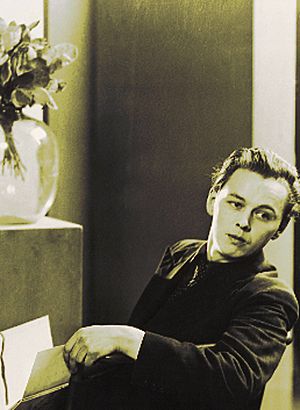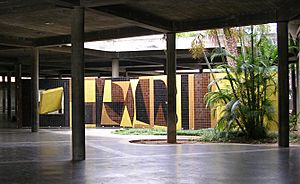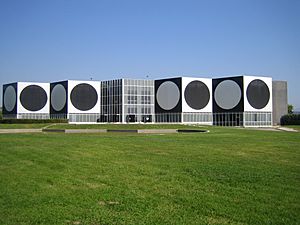Victor Vasarely facts for kids
Quick facts for kids
Victor Vasarely
|
|
|---|---|

Photograph circa 1930
|
|
| Born |
Győző Vásárhelyi
9 April 1906 |
| Died | 15 March 1997 (aged 90) |
| Nationality | Hungarian French |
| Education | Mühely |
| Known for | Painting and Sculpture |
| Movement | Op Art |
Victor Vasarely (born April 9, 1906 – died March 15, 1997) was a famous Hungarian-French artist. Many people call him the "grandfather" and a main leader of the Op art movement. Op art is a style of art that uses optical illusions.
One of his most famous early works is Zebra, made in the 1930s. Some people think this artwork is one of the very first examples of Op art.
Contents
Discovering Victor Vasarely's Life
Victor Vasarely was born in Pécs, Hungary. He grew up in different places like Pöstyén (now Piešťany, Slovakia) and Budapest. In 1925, he started studying medicine at Eötvös Loránd University.
However, he soon realized his true passion was art. In 1927, he stopped studying medicine to learn traditional painting. From 1928 to 1929, he joined a special art school in Budapest called Műhely. This school was known for teaching the Bauhaus style, which focused on design and art that could be used in everyday life.
In 1930, Victor married his fellow art student, Claire Spinner. They had two sons, Andre and Jean-Pierre. Jean-Pierre also became an artist and was known as 'Yvaral'. In Budapest, Victor worked as a graphic designer, creating advertising posters. He was good at mixing patterns and natural shapes in his designs.

Moving to Paris and Finding His Style
In 1930, Vasarely moved from Hungary to Paris, France. He continued working as a graphic artist for advertising companies. He didn't meet many other artists at first. He even thought about starting his own art school, like the one he attended in Budapest.
After World War II, he opened his own art studio near Paris. In 1961, he settled in Annet-sur-Marne. Over time, Vasarely started creating art and sculptures that used optical illusions. He developed his unique style of geometric abstract art. He used simple shapes and a limited number of colors in his works.
Early Artworks and Experiments (1929-1947)
From 1929 to 1944, Vasarely focused on early graphics. He played with textures, how things looked from different angles, and how light and shadow worked. Famous works from this time include Zebras (1937) and Chess Board (1935).
Between 1944 and 1947, he explored many different art styles. He tried cubistic, futuristic, and surrealistic painting. He later said he was "on the wrong track" during this period because he hadn't found his own unique style yet.
Developing Optical Art (1947-1955)
Finally, from 1947 to 1951, Vasarely found his own special style, which led to Op art. He was inspired by everyday things and places.
- Denfert: He was inspired by the white tiled walls of the Paris Denfert-Rochereau metro station.
- Belles-Isles: He found smooth pebbles and shells on a vacation in Brittany in 1947. These inspired his "Belles-Isles" artworks.
- Gordes/Cristal: From 1948, he spent summers in Gordes, where the cube-shaped houses gave him ideas for his "Gordes/Cristal" series. He explored how empty and filled spaces look on a flat surface and how we see things in 3D.

From 1951 to 1955, he created kinetic images and black-and-white artworks. He used layers of acrylic glass to make art that seemed to move as you walked past it. He also combined photographs into single, two-color images.
A major work from this time is Tribute to Malevitch (1954). It's a huge ceramic wall picture, 100 square meters large, at the University of Caracas. He designed it with architect Carlos Raúl Villanueva. During this time, kinetic art, which is art that moves or seems to move, became very popular.

Exploring New Art Forms (1955-1965)
From 1955 to 1965, Vasarely developed his ideas of serial art. In 1959, he patented his method of "plastic units." This meant he would cut geometric shapes from colored squares and rearrange them.
He used a very specific set of colors and shapes, which he later expanded and numbered. From this "plastic alphabet," his assistants could create many different versions of his art. This idea questioned whether a work of art had to be unique if it could be made by a system. In 1963, he called this system Folklore planetaire.
Later Works and Legacy (1965-1997)
After 1965, Vasarely created the Hommage à l'hexagone series. These works used endless changes of shapes and colors to create a "perpetual mobile of optical illusion." His Vega series made flat grids look like they were swelling into spheres, creating a strong optical illusion of volume.
In 1965, Vasarely's work was shown in a big exhibition called The Responsive Eye at the Museum of Modern Art.
Victor Vasarely opened his first museum in 1970 in Gordes, France, which showed over 500 of his works. Another important project was the Foundation Vasarely in Aix-en-Provence, which opened in 1976. Sadly, this museum is now in need of repair.
Also in 1976, a large moving artwork by Vasarely was placed in the Centre Pompidou in Paris. A Vasarely Museum was also opened in his hometown of Pécs, Hungary, with many of his donated artworks. In 1982, 154 of his special serigraphs (prints) were taken into space by a cosmonaut and later sold for a good cause. In 1987, a second Hungarian Vasarely museum opened in Budapest.
Victor Vasarely passed away in Paris on March 15, 1997, at the age of 90. His art continues to be celebrated and displayed in museums around the world.
Awards and Recognition
Victor Vasarely received many important awards for his art:
- 1964: Guggenheim Prize
- 1970: French Chevalier de L'Ordre de la Légion d'honneur (a very high French award)
- Art Critics Prize, Brussels
- Gold Medal at the Milan Triennial

Museums Featuring Vasarely's Art
You can see Victor Vasarely's amazing art in these museums:
- 1970-1996: Vasarely Museum in Gordes Palace, Vaucluse, France (now closed)
- 1976: Fondation Vasarely, Aix-en-Provence, France
- 1976: Vasarely Museum, Pécs, Hungary
- 1987: Vasarely Museum, Zichy Palace, Óbuda, Budapest, Hungary
Images for kids
See also
 In Spanish: Victor Vasarely para niños
In Spanish: Victor Vasarely para niños






